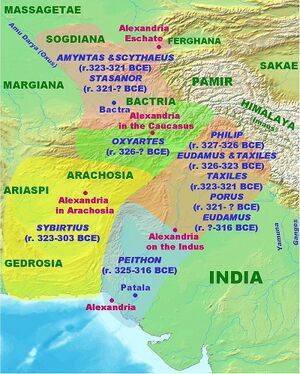Eudemus
| Wikifier:Laxman Burdak, IFS (R) |

Eudemus (died 316 BC) was one of Alexander the Great's generals. In 326 BC, he was appointed by Alexander as one of the commanders of the troops in India along with Peithon, Porus and Taxiles. After Alexander's death, Eudemus assassinated Porus and effectively controlled Alexander's northern Indian territories until he became involved in the Wars of the Diadochi during which he was captured and killed by Antigonus.
Variants
Jat Gotras Namesake
History
According to Diodorus Siculus after Alexander's unexpected death in 323 BC, Eudemus assassinated the Indian king Porus.[3] As a result, Eudemus became very powerful and in 317 BC, he was able to support Eumenes of Cardia in his war against Antigonus by providing a force of 500 cavalry, 300 infantry, and 120 war elephants.[4]
Eudemus and his troops saw active service in the first Battle of Gabiene, although his troops suffered considerably from an attack by Antigonus.
It seems nevertheless that Eudemus was jealous of Eumenes and joined in the conspiracy of Antigenes and Teutamus against him. As a result, Eumenes was betrayed to Antigonus by these officers under his command. Eumenes lost control of his army's baggage camp which included all the loot of the most decorated Macedonian veterans (called the Argyraspides, or Silver Shields). This treasure had been accumulated over 30 years of successful warfare. Antigonus responded to a request for the return of the baggage train sent by Teutamus, one of their commanders, by demanding they give him Eumenes. The Silver Shields agreed to this.
Following the surrender of Eumenes, Eudemus was put to death by order of Antigonus, to whom Eudemus had always shown a marked hostility. [5]
Death of Poros
Buddha Prakash[6] mentions ....[p.91]: After the occupation of Pataliputra and the eradication of Nanda rule, Kautilya encompassed the murder of Poros through the Greek general Eudamus who is probably Dingarāta of the Mudraraksasa who, as this drama suggests, did it through a poison-girl.
On the death of Poros, Candragupta was the undisputed master of the empire of northern India. Poros' son Malayaketu broke away from Candragupta and joined the minister of the former Nanda king, but Kautilya won over that minister leaving him in the lurch. Eventually Malayaketu was captured and presented before Candragupta, but, through the intercession of Kautilya, his ancestral kingdom in the Panjab was restored to him and he returned there with his associates. He also patched up his affairs with Eudamus and, at his instance, went to Iran to assist Eumenes against Antigonus in the battle of Gabiene in 316 B. C. But in that battle he died and his kingdom was annexed to the Maurya empire (Buddha Prakash, Studies in Indian History and Civilization, pp. V I38-141).
[p.92]: It is clear from the above account that the Maurya empire was the creation of the Panjabis. It was they who laid its foundations in the Panjab under the leadership of Poros, Candragupta and Kautilya and then spread it up to Magadha. After that they took a prominent part in its conservation and proved its ardent defenders. This was demonstrated on the occasion of the invasion of Seleucos in 305 B. C.
Jat History
Bhim Singh Dahiya[7] Another indication of the foreign nature of these people (Mauryas) is given by the Puranas and other Indian works. The Vishnu Purana calls them Sudras. The Markandeya Purana brands the Mauryas as Asuras. Yuga Purana called them "utterly irreligious, though posing as religious". The Mudra Rakshasa calls these people as Mlecchas and Chandragupta himself is called 'Kulahina, i.e., an upstart of unknown family. In the same drama, a character Dingarata (डिन्गराट) figures in the retinue of Chandragupta and Malayaketu. This name is manifestly non-Indian.[8]
References
- ↑ Bhim Singh Dahiya: Jats the Ancient Rulers (A clan study)/Porus and the Mauryas, p.147
- ↑ Buddha Prakash:Evolution of Heroic Tradition in Ancient Panjab, IX. The Contribution to the Maurya and Sunga Empires, p.92
- ↑ Williams, Henry Smith. The Historians' History of the World Vol.2 (of 25) (Illustrations): Israel, India, Persia, Phoenicia, Minor Nations of Western Asia. THE TROW PRESS.
- ↑ Diodorus Siculus, Bibliotheca, xix. 14
- ↑ Diodorus, xix. 15, 27, 44; Plutarch, Parallel Lives, "Eumenes", 16
- ↑ Buddha Prakash:Evolution of Heroic Tradition in Ancient Panjab, IX. The Contribution to the Maurya and Sunga Empires, p.91
- ↑ Bhim Singh Dahiya: Jats the Ancient Rulers (A clan study)/Porus and the Mauryas, p.147
- ↑ SIH&C, p. 140

